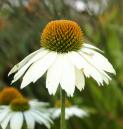(A lot of the Boraginaceae contain toxic pyrrolizidine alkaloids. These alkaloids were unknown when this book was written. More info here: Livertoxic PAs --Henriette.)
Cynoglossum. Cynoglossum officinale L. Hound's-tongue. Langue de Chien, Fr. Hundszunge, G.—A biennial plant of the fam. Boraginaceae, common both in Europe and in this country. The leaves and root have been employed, but the latter has been generally preferred. The fresh plant has a disagreeable narcotic odor, resembling that of mice, which is dissipated by drying. The taste is nauseous, bitterish, and mucilaginous. Although hound's-tongue has been believed by some to be nearly inert, there can be little doubt that it is a dangerous poison. The experiments of Diediilin (M. S. Rep., 1868) many years ago demonstrated that the extract paralyzes motor nerves in vertebrate animals, and K. Greimer has found in it a poisonous alkaloid, cynoglossine, which acts upon the animal organism similarly to curare; also a toxic glucoside, consolidin, and a notable amount of choline. (P. J., vol. lxv.) Consolicin, a derivative of consolidin, like consolidin, paralyzes the central nervous system. Cynoglossum has been used as a demulcent and sedative in coughs, catarrh, spitting of blood, dysentery, and diarrhea. The pilulae de cynoglosso owe their properties chiefly to opium.

